Management Assignment Reviewing Articles Based on Organisational Management
Question
Task: Your task is to select four articles based on business management and prepare a report on management assignment addressing the following questions:
1. Citation of the paper in APA (6th ed.) format:
2. Does the paper convincingly highlight the purpose and justification of the study? Justify your answer. It is better that you cite from the introduction as an evidence of your answer.
3. Does the paper persuasively develop the theoretical basis of the study? Justify your answer. It is better that you cite from the manuscript as an evidence of your answer.
4. Does the paper clearly explain the research design and other methodological issues? Justify your answer. It is better that you cite from the manuscript as an evidence of your answer.
5. Does the paper discuss the results credibly with theoretical lens and empirical evidence? Justify your answer. It is better that you cite from the manuscript as an evidence of your answer.
6. What did you learn from this paper? It may be in terms of theory, methodology, findings etc. Please specify.
Answer
First Article
This part of the management assignment has given answer to all the six questions, which are provided in the guidelines.
First Question
Azim, T. M. (2016). Corporate Social Responsibility and employee behavior: mediating role of organizational commitment. Review of Business Management, 18(60), 207-225.
Second Question
Mohammed Tahlil Azim has convincingly highlighted the purpose and justification of the study. The purpose of the study is to examine the relationship between perceived CSR and job engagement of employees in an organisation. It is clear from the introduction of the article that the author is eager to understand the impact of CSR on employee attitude and employee behaviour in an organisation. It is also identified in the introduction section of the article that CSR is perceived to be a positive aspect for good employee outcomes and positive financial performance.
It is also highlighted in the introduction that organisations generally use CSR as a competitive tool to attain business growth. The introduction of these claims and aspects related CSR significantly indicates that Mohammed Tahlil Azim has convincingly highlighted the justification and purpose of the study.
Third Question
Mohammed Tahlil Azim has successfully developed the theoretical basis of the study. It is identified in the “Theoretical Link” section that the author has mentioned Social Identity Theory and Social Exchange Theory in order to establish the strong relationship between CSR and employees’ attitude. After this, Mohammed Tahlil Azim also has discussed the theoretical insights of Social Exchange Theory and Social Identity Theory.
Through the application of both of these theoretical aspects, the author has convincingly developed the theoretical basis of the study that the CSR activities allow the organisations to maintain positive attitudes and enthusiastic behaviour in the workplace. Some of the manuscripts are sourced from the article and provided below.
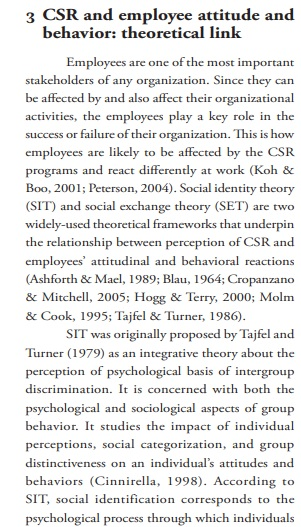
Figure 1: Manuscript
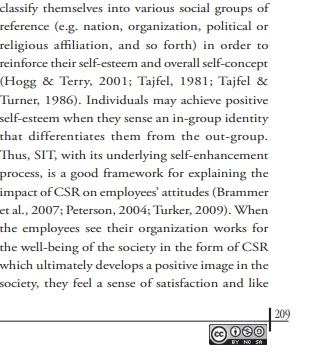
Figure 2: Manuscript
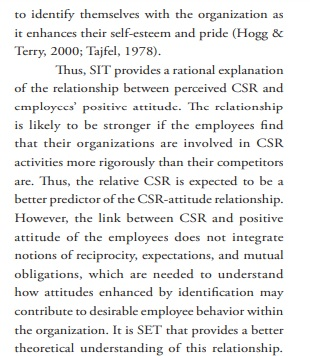
Figure 3: Manuscript
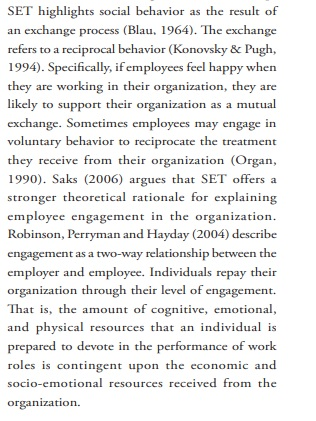
Figure 4: Manuscript
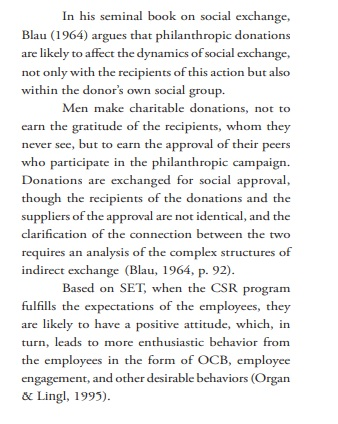
Figure 5: Manuscript
From the above manuscripts, it is clearly identified that Mohammed Tahlil Azim has persuasively developed the theoretical basis of the study.
Fourth Question
Mohammed Tahlil Azim has clearly explained the research design and other methodological issue. In the “Research Framework” Section, the author has clearly mentioned about the research gap, which is identified in the introduction section. The manuscript evidence is provided below.
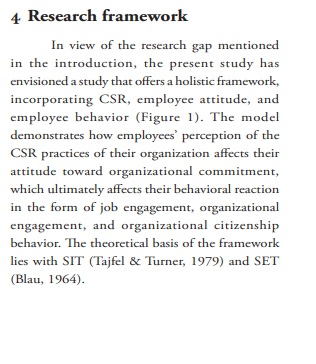
Figure 6: Manuscript
In the introduction section, the author has clearly mentioned that there are very few secondary sources, which have discussed about the impact of CSR on employee engagement. This is the only research design issue identified in this article.
Fifth Question
The article has discussed the results credibly with empirical evidence and theoretical lens. It is already identified that Social Exchange Theory and Social Identity Theory is used to prove that CSR activities have positive impacts on employee engagement and employee behaviour in the workplace. The following manuscript will also give the proof of empirical evidence.
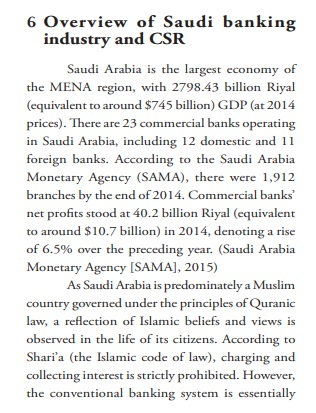
Figure 7: Manuscript
The above manuscript is clearly indicating that Mohammed Tahlil Azim has used the case study of Saudi Banking Industry as empirical evidence.
Sixth Question
Mohammed Tahlil Azim has done a thorough and in-detailed analysis. The methodological section has impressed me as the researcher has taken care of the comfort level of the participants by translating the interview questions from English to Arabic. This has allowed the researcher to maintain the ethics of the research.
Second Article
This part of the assignment has given answer to all the six questions, which are provided in the guidelines.
First Question
Morris, A., & Feldman, C. D. (1996). The Dimensions, Antecedents, and Consequences of Emotional Labor. Academy of Management Review, 21(4), 986-1010.
Second Question
The purpose of this article is to identify and discuss the dimensions, antecedents, and consequences of emotional labour. Hence, the authors of this article have developed three important goals of this article in the introduction section. The discussion about four distinct dimensions of emotional labour is also highlighted in the introduction section. In addition, it is also introduced that employee monitoring and job characteristics of the employees might be important antecedents of emotional labour. According to several previous researchers, emotional labour has negative impact on the job satisfaction of the employees. In order to understand the actual impact of emotional labour on the workers, the conduction of this research work is highly purposive and justified.
Third Question
This article has persuasively developed the theoretical basis of the study. The authors of this article have set-up three important goals, such as identification of dimensions, antecedents, and consequences of emotional labour. Most importantly, the authors have successfully used the references of different scholars in order to discuss the dimensions of emotional labour. Apart from these, it is also identified that the authors have developed a diagram or framework in order to display the relationships among the four dimensions of emotional labour. It has successfully provided the theoretical base of this article. The manuscript of this theoretical diagram or framework is given below.
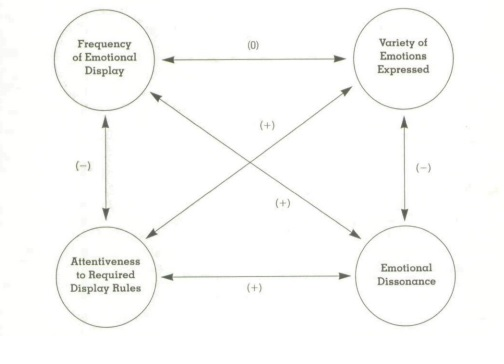
Figure 8: Manuscript
Apart from these, the authors also have used the reference of Person-Environment Fit Theory in order to discuss the dimensions of emotional labour associated with job satisfaction. The theoretical findings of the study have clearly explained that the researchers need to continue these types of investigations in order to gain more insights on emotional labour. Overall, this study will become a positive theoretical base for the future research works.
Fourth Question
This article has clearly explained the research design and methodological issue. Most importantly, the researchers have mentioned the usefulness of different research as well as methodological approaches. For example, the authors have given the examples of the use of direct observation method, self-reporting method, and questionnaire method. The following manuscript can be used the evidence of it.
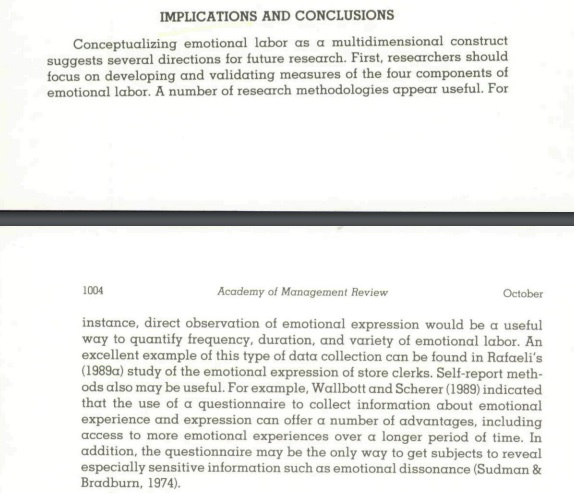
Figure 9: Manuscript
However, both the authors have given their preference and justification regarding the use of questionnaire method as the authors think that use of direct observation method and self-reporting method cannot reveal sensitive information related to emotional labour and employee satisfaction.
Fifth Question
This article has clearly discussed the credible results by the help of theoretical lens and empirical evidence. Following manuscript can be considered as an empirical evidence.
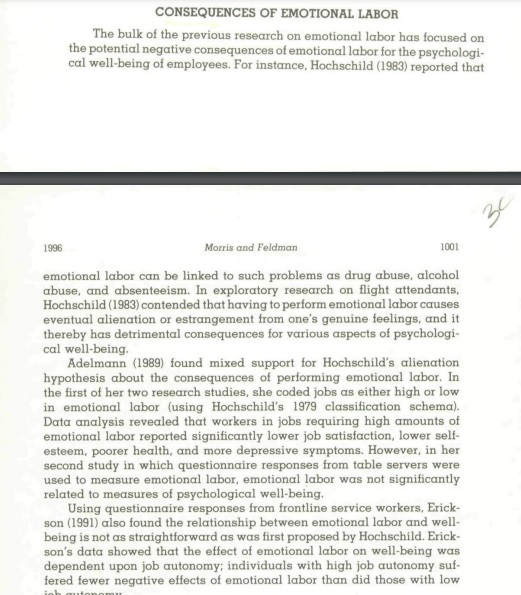
Figure 10: Manuscript
It is clear from the above manuscript that the authors of this article have used the reference of Erickson in order to use questionnaire responses. This reference has indicated the authors of this article that Emotional labour is not positively related with employee wellbeing.
Sixth Question
The authors have thoroughly used the views of different scholars and researchers to identify and discuss the dimensions, antecedents, and consequences of emotional labour. Extensive use of theoretical concepts has indicated that emotional traits need to be controlled for better performance. Hence, I have learnt that extensive use of theoretical frameworks and concepts are important to achieve the research objectives.
Third Article
This part of the assignment has given answer to all the six questions, which are provided in the guidelines.
First Question
Wynes, J., Dooren, V. W., Mattijs, J., & Deschamps, C. (2018). Linking turnover to organizational performance: the role of process conformance. Public Management Review, 21(5), 669-685.
Second Question
Major purpose of the article is to identify the impact of process conformance on the employee turnover-employee performance relationship in a public sector context. In the introduction section of the article, it is clearly mentioned by the authors that high employee turnover can have positive impacts on the workplace performance of the employees. On the other hand, the authors of this article also have mentioned in this introduction section that employee turnover has a negative impact on the workplace performance. Overall, the authors have mentioned the views of different researchers regarding these mixed responses on impact of employee turnover. In order to get a prompt research outcome, the authors have decided to conduct this research. The conduction of this research work is highly justified as it may help in determining the actual impact of employee turnover on workplace performance of a company.
Third Question
This article has persuasively developed the theoretical basis of the study. The authors have significantly used Social Capital Theory and Human Capital Theory in order to understand the possible impacts of high employee turnover on the workplace performance of the employees. Following manuscripts will provide the evidence.
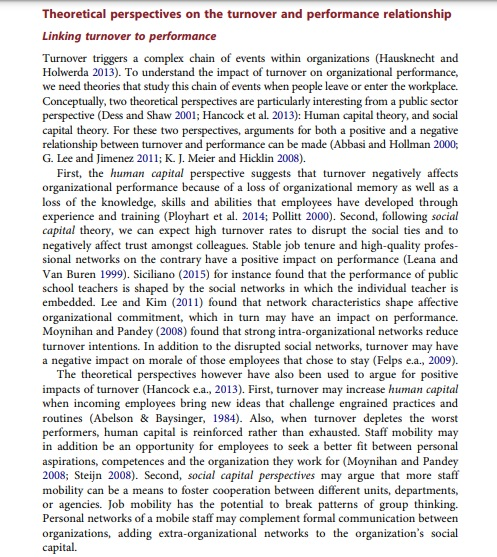
Figure 11: Manuscript
The use of human capital theory has suggested that high employee turnover can lead to negative organisational performance due to loss of skill, loss of knowledge, and loss of ability. On the other hand, use of social capital theory has suggested that logical employee turnover can improve the workplace performance of a company. Hence, it is clarified that the article has provided important theoretical bases for future researchers through the use of these two theoretical perspectives.
Fourth Question
The authors have used secondary data in this article. Most importantly, homogeneity of the samples has helped the researchers to strengthen the collected data. Moreover, this homogeneity nature of the selected samples also has helped the authors to overcome the possibilities of different methodological errors. Hypothesis are developed and tested in this article in order to ensure appropriate research outcome. Moreover, use of System-GMM Model has successfully estimated the causal effect of employee turnover in the organisational performance. Use of this method has helped the authors of this article to overcome the possibilities of flawed research outcome. Following manuscript will provide the evidence.
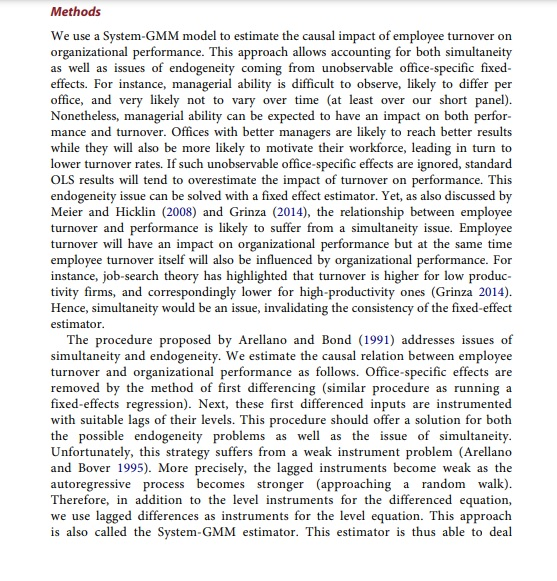
Figure 12: Manuscript
The above manuscript indicates that System-GMM model in methodology section has allowed the researcher to overcome the endogeneity or inequality issues.
Fifth Question
The regression analysis has been done in this article to establish the link between employee turnover and organisational performance. From the regression analysis, it is identified that logical turnover cannot hamper the workplace performance of the organisation. Following manuscript will provide the evidence.
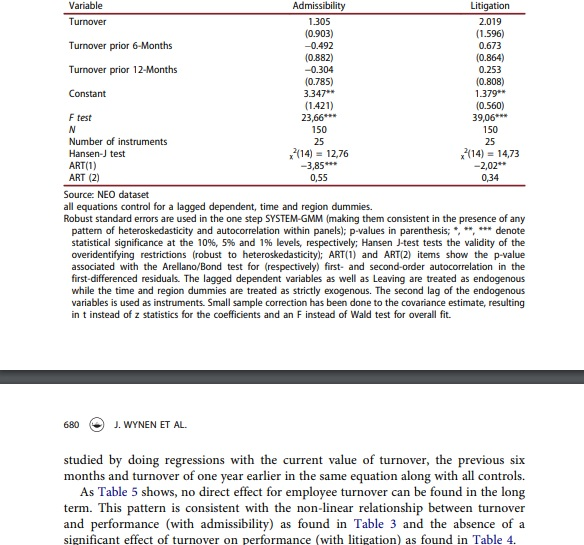
Figure 13: Manuscript
It is also clear from the manuscript that the organisations might have limited short-term impact on workplace performance of employees, but this might hamper the performance level as well as motivation level of the staffs for a longer period of time.
Sixth Question
I have learn from this article that there may be two types of perceptions regarding the impact of employee turnover on performance level of firms, but appropriate statistical and regression analysis can assist the researchers to know the actual impact as this analysis considers actual cases as empirical evidence.
Fourth Article
This part of the assignment has given answer to all the six questions, which are provided in the guidelines.
First Question
Hurtz, M. G., & Donovan, J. J. (2000). Personality and Job Performance: The Big Five Revisited. Journal of Applied Psychology, 85(6), 869-879.
Second Question
Major purpose of this article is to offer a meta-analytic assessment of the criterion-related validity of clear Big 5 measures in order to predict job performance as well as contextual performance. The authors of this article have shown their concerns that past meta-analytic reviews contain statistical as well as methodological issues. The authors also have discussed in the introduction section of the article that “Big Five Personality Tool” is a dominant personality framework, which is being used for a longer period of time. Therefore, the authors decided to conduct a meta-analysis to analyse the body of the research in which the relationship between job-performance and Big Five Personality Framework can be successfully assessed. Facts collected from the introduction section of the article clearly indicate that the paper has convincingly highlighted the purpose and justification of the study.
Third Question
From the article, it is identified that the authors have tried really hard to identify any possible relationship between Big Five Personality Framework and Job Performance. However, both the researchers have become successful in identifying positive relationship between Big Five Personality Framework and Job Performance. It is identified that the article does not properly develop the theoretical basis of the study. Following manuscript will give this evidence.
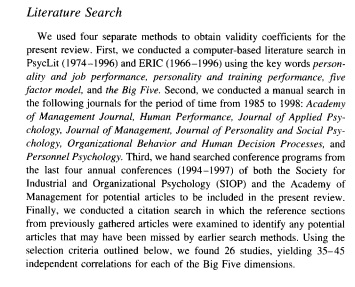
Figure 14: Manuscript
Only a small part related to literature review and theoretical framework has been considered by the authors in this article. It is clearly mentioned in the article that a computer-based literature search has been considered by the authors in this article. The authors did not elaborately discuss the Big Five Personality Framework in Literature Review or Theoretical Framework Section. It can be considered as a weakness of this particular article.
Fourth Question
The authors have clearly discussed the methodological and statistical issues in this article. Following manuscript will be considered as a real evidence of this.
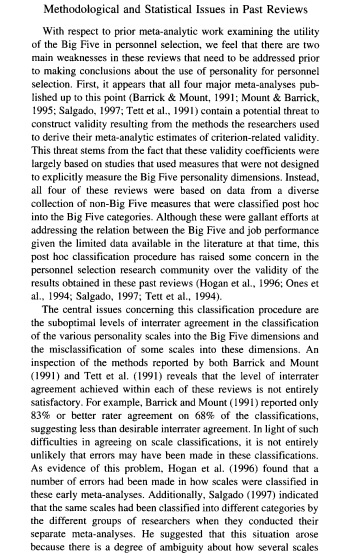
Figure 15: Manuscript
It is clearly identified from the above manuscript that authors have discussed about two major weaknesses of meta-analytic work. In terms of methodological issues, the authors have mentioned that classification procedures are of suboptimal level.
Fifth Question
In terms of results and findings, it is identified that the authors have presented the results of omnibus meta-analysis across the performance and occupation criteria. From the findings, it has been identified that both the researchers have come to the conclusion that the conducted meta-analysis is successful in providing a review of criterion-related validities of dimensions of Big Five Personality Framework. Following manuscript will be considered as a real evidence of this.
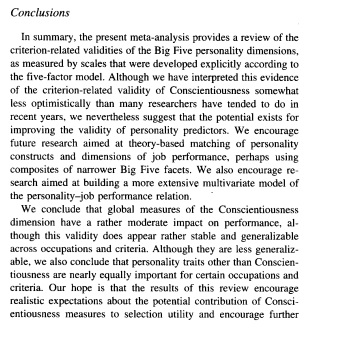
The conclusion of the report is drawn from the findings and it is identified that big five personality dimensions have positive impacts on performance level of employees. Therefore, meta-analysis is highly relevant for the context of Big Five Personality Framework.
Sixth Question
I have learn an important thing from this research article that in-detailed analysis of research is important to overcome the issues and errors associated with a particular theoretical framework as it can help in providing benchmarking pathway for the future research works.
References
Azim, T. M. (2016). Corporate Social Responsibility and employee behavior: mediating role of organizational commitment. Review of Business Management, 18(60), 207-225.
Hurtz, M. G., & Donovan, J. J. (2000). Personality and Job Performance: The Big Five Revisited. Journal of Applied Psychology, 85(6), 869-879.
Morris, A., & Feldman, C. D. (1996). The Dimensions, Antecedents, and Consequences of Emotional Labor. Management assignment Academy of Management Review, 21(4), 986-1010.
Wynes, J., Dooren, V. W., Mattijs, J., & Deschamps, C. (2018). Linking turnover to organizational performance: the role of process conformance. Public Management Review, 21(5), 669-685.












